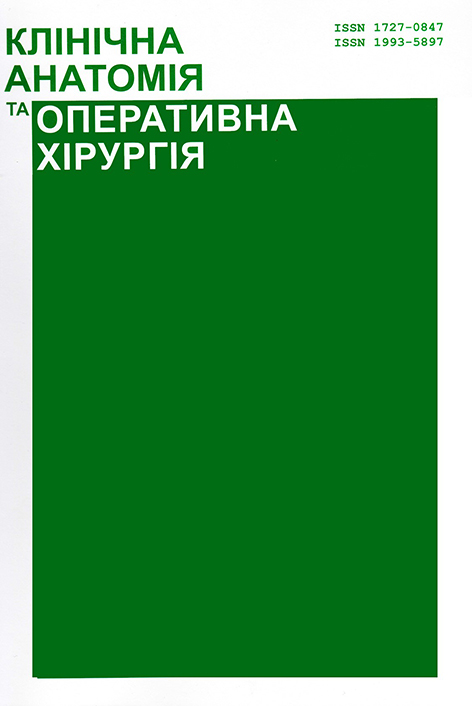ВПЛИВ ТРИВАЛОГО ОСВІТЛЕННЯ НА СУБМІКРОСКОПІЧНІ ЗМІНИ СУПРАХІАЗМАТИЧНИХ ЯДЕР ГІПОТАЛАМУСА
DOI:
https://doi.org/10.24061/1727-0847.14.4.2015.21Ключові слова:
супрахіазматичні ядра гіпоталамуса, постійне освітленняАнотація
Досліджено субмікроскопічну організацію пейсмекерних клітин вентролатерального відділу супрахіазматичних ядер переднього гіпоталамуса щурів. За стандартного режиму освітлення (12.00С:12.00Т) ультраструктура пейсмекерних нейронів свідчить про зниження їх функціональної активності у світловий та зростання – у темновий період доби. Тривалий світловий стрес (24.00C:00T) призводить до істотного десинхронозу циркадіанного пейсмекера та пригнічення його активності впродовж періоду спостереження. Моделювання гіпофункції шишкоподібної залози спричинює деструктивні зміни компонентів досліджуваних структур, які більш виражені о 02.00 год.Посилання
Anisimov VN. The light-dark regimen and cancer development. Neuroendocrinol. Lett. 2002; 23 (Suppl 2): 28-36.
Venegas C, Garcіa JA, Escames G. Extrapineal melatonin: analysis of its subcellular distribution and daily fluctuations. J. Pineal Res. 2012; 52 (2): 217-227.
Zamorskiy II, Pishak VP. Funktsionalnaya organizatsiya fotoperiodicheskoy sistemy golovnogo mozga [Functional organization of the photoperiodic system of the brain]. Uspekhi fiziologicheskikh nauk. 2003; 34 (4): 37-53 (in Russian).
Logvinov SV, Gerasimov AV. Circadian system and adaptation. Morphofunctional and radiobiological aspects. Tomsk: Pechatnaya manufaktura, 2007; 200 (in Russian).
Cantwell EL, Cassone VM. Chicken suprachiasmatic nuclei: I. Efferent and afferent connections. J. Comp. Neurol. 2006; 496 (1): 97-120.
Saeb-Parsy K, Dyball R. Responses of cells in the rat supraoptic nucleus in vivo to stimulation of afferent pathways are different at different times of the light/dark cycle. J. Neuroendocrinol. 2004; 16 (2): 131-137.
Kiessling S, Sollars PJ, Pickard GE. Light stimulates the mouse adrenal through a retinohypothalamic pathway independent of an effect on the clock in the suprachiasmatic nucleus. PLoS One. 2014; 9 (3): 929-959.
Pertsov SS. Rol suprakhiazmaticheskogo yadra gipotalamusa v realizatsii effektov melatonina na timus, nadpochechniki i selezenku krys [The role of the suprachiasmatic nucleus of the hypothalamus in the realization of the effects of melatonin on the thymus, adrenals and spleen of rats]. Bulletin of Experimental Biology and Medicine. 2006; 141 (4): 364-367 (in Russian).
Gerasimov AV. Funktsionalnaya morfologiya neyronov suprakhiazmaticheskikh yader krys posle kombinirovannogo vozdeystviya rentgenovskogo izlucheniya i sveta [Functional morphology of suprachiasmatic nucleus neurons of rats after combined effects of light and X-rays]. Radiation Biology. 2003; 43 (4): 389-395 (in Russian).
Benarroch EE. Suprachiasmatic nucleus and melatonin: reciprocal interactions and clinical correlations. Neurology. 2008; 71 (8): 594-598.
Reynolds ES. The use of lead citrate at high pH as an electronopague stain in electron microscopy. J. Cell. Biol. 1963; 17: 208-212.
##submission.downloads##
Опубліковано
Номер
Розділ
Ліцензія
Авторське право (c) 2017 Клінічна анатомія та оперативна хірургія

Ця робота ліцензується відповідно до Creative Commons Attribution-NonCommercial-ShareAlike 4.0 International License.
ВІДКРИТИЙ ДОСТУП
а) Автори залишають за собою право на авторство своєї роботи та передають журналу право першої публікації цієї роботи на умовах ліцензії Creative Commons Attribution License, котра дозволяє іншим особам вільно розповсюджувати опубліковану роботу з обов'язковим посиланням на авторів оригінальної роботи та першу публікацію роботи у цьому журналі.
б) Автори мають право укладати самостійні додаткові угоди щодо неексклюзивного розповсюдження роботи у тому вигляді, в якому вона була опублікована цим журналом (наприклад, розміщувати роботу в електронному сховищі установи або публікувати у складі монографії), за умови збереження посилання на першу публікацію роботи у цьому журналі.
в) Політика журналу дозволяє і заохочує розміщення авторами в мережі Інтернет (наприклад, у сховищах установ або на особистих веб-сайтах) рукопису роботи, як до подання цього рукопису до редакції, так і під час його редакційного опрацювання, оскільки це сприяє виникненню продуктивної наукової дискусії та позитивно позначається на оперативності та динаміці цитування опублікованої роботи (див. The Effect of Open Access).



